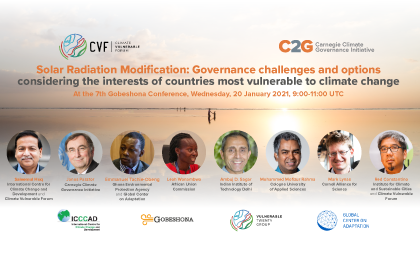2 events in March highlighted the growing need for SRM governance today

Two events in late March underscored the importance of C2G’s mission to catalyse the creation of effective governance for solar radiation modification (SRM) – in a way that takes account of a full range of views about risks, trade-offs, benefits and synergies.
On March 25, the National Academies of Science, Engineering and Medicine in the USA issued a report calling for a $100-200m US research programme over 5 years into certain forms of SRM, which included recommendations about the need for international collaboration and governance.
A week after the NASEM report, the Stratospheric Controlled Perturbation Experiment (SCoPEx), a scientific experiment to advance understanding of stratospheric aerosols that could be relevant to solar radiation modification, postponed an equipment test flight scheduled for June in Sweden.
The postponement followed opposition from a limited number of non-state actors (NSAs) – who said there had been insufficient consultation, and some who also oppose SRM in principle. The SCoPEx independent advisory committee subsequently recommended that “societal engagement should occur before any research is conducted”.
These two events were different, but related. One was a call by the influential National Academies in the USA to do more research into SRM, with appropriate governance. The other showed how existing governance processes may not be up to the task to govern an experiment of that kind and need rethinking.
Both events, and the varying reactions, underscore how much views differ about whether or not SRM should even be discussed; researched; and whether or not one day SRM should be used. They also show that governance frameworks to weigh up a variety of views are insufficient, and how currently only a limited number of players are engaged and are de facto setting the agenda. This matters, as results of governance processes today (or their lack of) can frame conversations for years.
A similar example of this was the unsuccessful attempt to reach agreement on a UN Environment Assembly (UNEA) resolution on a global assessment on the status of CDR and SRM, where insufficient information and lack of full engagement of all actors resulted in the inability to reach consensus.
Why is SRM governance needed now?
With SRM debate and research proposals already underway, governance is needed to address the big question of whether or not to consider, and whether or not eventually to make use of SRM one day.
If the answer is no, the world will need to deal with the challenges of a smaller potential toolkit to deal with the risks of climate change. If the answer is yes, it will need to develop approaches to minimise risks– both known and unknown – against the backdrop of insufficient climate action in a dangerously warming world.
Governance is also needed to provide assurances to the public that safety, transparency, accountability and liability issues are being addressed, as well as issues of intra– and inter-generational justice.
It is not for C2G to judge whether specific instances of governance are appropriate or not, but we do think it is important to understand governance as a broad concept (see our infographic here), which includes processes to enable a range of stakeholders to engage, as well as regulatory processes by governments and NSAs. SRM governance should include publics and the most vulnerable from around the world.
Do we need specific governance for SRM research?
It is not so easy to draw conclusions about the need for governance of SRM research, as something separate from governance of SRM as a whole.
Questions which seem to be about research governance may be more fundamentally about governance of deployment. There is a lack of clarity on this, or whether there should be SRM research at all, and more discussion is needed.
Governance of research can include guard rails for how research should be conducted. It can, however, also include guidance for the direction and to some extent the content of research to be undertaken. An example of the latter is international policy guidance on the research of ‘climate-related geo-engineering‘ in the Convention on Biological Diversity – which called for more transdisciplinary research in this area, as part of a broader decision on guidance in relation to ‘geo–engineering’.
Some stakeholders may call for more guidance, including mission-oriented research, to better understand SRM.
I will address one other concern here, as it is so often cited: the idea that SRM research could create a ‘slippery slope’ towards deployment. This does need to be addressed. For some, the idea that research makes deployment more likely is a reason in itself to oppose research.
However, others question this contention, citing a lack of evidence. And a slope can go both ways. In fact, some suggest there is an uphill struggle to learn more about and discuss SRM, and that given the state of the climate emergency, the greater risk may lie in not expanding knowledge about SRM.
Catalysing SRM governance in international processes
C2G approaches the governance of SRM in its entirety, and with that approach in mind we have and will continue to catalyse several international processes which engage a wide range of stakeholders, including in the UNEA and in various regional fora, to further that discussion.
Notably, in 2019, Switzerland brought a resolution to the 4th session of the UNEA to commission a study by the UN Environment Programme (UNEP) of climate-altering approaches.
Many supported, some opposed, some didn’t know enough, and the resolution was withdrawn due to lack of consensus. The good news, however, was that the conversation led to considerable intra- and intergovernmental consultations of the issues by many countries, and there are efforts underway to broach the subject again at the resumed 5th session of UNEA in 2022.
A UN-supported study of the risks, benefits and governance challenges of climate-altering techniques, including of SRM, would considerably improve the knowledge base of these approaches, and thereby contribute to levelling the currently very uneven playing field of information access between the Global North and the Global South.
Looking ahead, one of C2G’s main goals is to catalyse an initial consideration by the UN General Assembly of how to address SRM at the international level. While it will be up to governments to decide what the outcome of such an initial consideration might be, based on C2G’s consultations so far, the main need seems to be learning and increased understanding of the risks, benefits, and of the governance challenges of these emerging climate-altering approaches.
C2G will undertake bilateral consultations with a range of countries to test what seems to be a growing interest in engaging in such conversations, and to explore the kind of framings within which SRM might best be considered.
We also recognize that many different international processes have different roles in SRM governance due to their different mandates. Does SRM require a comprehensive framework bringing this together, a polycentric patchwork of instruments and measures, or even a new institution, or a mixture of these options?
C2G does not have the answer to these questions, nor should we – and there is much yet to learn before conclusions are drawn.
That is why we at C2G are asking more governments, international organisations and non-state actors everywhere to get engaged now. It is important to include a broader range of interlocutors in SRM governance processes, including from the Global South, in order to level the playing field and so that a limited group of actors do not dominate such a crucial debate. C2G cannot do this by itself, and will be looking forward to catalyse others to help in levelling the playing field.
We do not take a position on the specifics, but we do think that governance needs to be multi-faceted, and not confined to the most privileged or the most active stakeholders.
As always, we invite you to help us in expanding this debate.
_______________
[1] The author would like to thank contributions from a number of C2G colleagues for this blog.
Related posts:
What implications could SRM have for the SDGs?
Guest post by Matthias Honegger, Axel Michaelowa, and Jiahua Pan



0 Comments